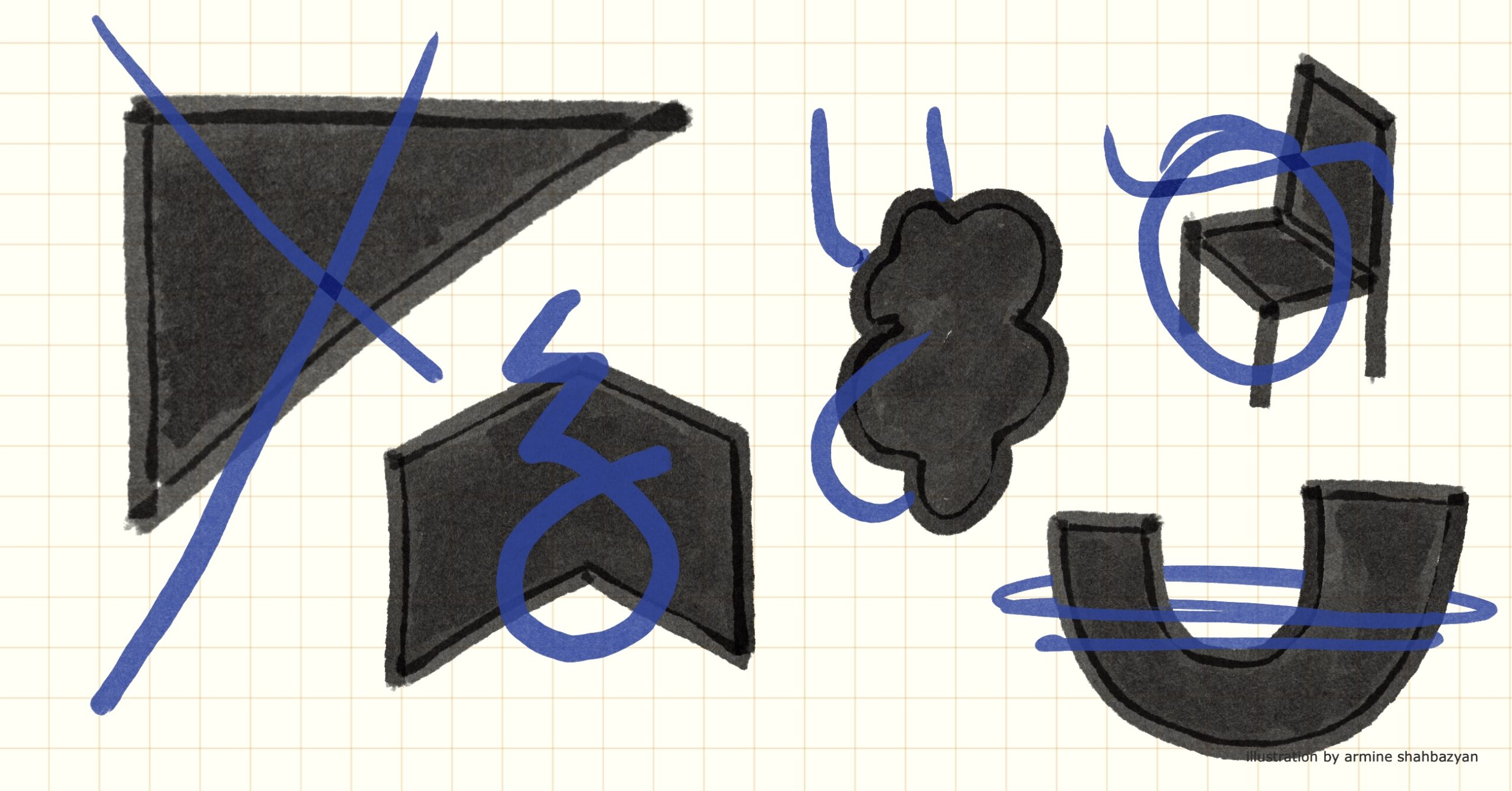
Visiting one post-Soviet state, you can then recognize it in all others – the similar patterns of urban planning and the identical buildings, structures, roads, pipes, wires, tiles, etc. However, an outsider delving inside under the extreme familiarity of the material environment finds an extreme “strangeness” of social interactions and practices. The “Outside In” series is about emplaced paradoxes and nuances. It spotlights the mundane in Armenia’s peripheral locations, where the seemingly unspectacular encounters with people and things allowing us to capture the unique features of the territory.
Listen to the article.
Outside In
Essay 8
Ի սկզբանէ էր Բանն, եւ Բանն էր առ Աստուած, եւ Աստուած էր Բանն: Նա էր ի սկզբանէ առ Աստուած: Ամենայն ինչ նովաւ եղեւ, եւ առանց նորա եղեւ եւ ոչ ինչ որ ինչ եղեւն:
In the beginning was the Word, and the Word was with God, and the Word was God. The same was in the beginning with God. All things were made by him; and without him
was not anything made that was made.
(John 1:1–3. King James Bible)
Notes on the Armenian Language From a Humble Foreigner
Learning the Armenian language can be tough, but not as tough as it may seem. After the aorta-rupturing shock of the 39-letter alphabet that resembles nothing else in the world, you will delve into phonetics, grammar, and vocabulary. The phonetics, with aspirated and non-aspirated consonants, is a tier of hell. Distinguishing between the two ‘ts’ ծ/ց is mission impossible for most foreign learners.
But, every cloud has a silver lining. For those whose mother tongue belongs to the Indo-European family of languages, Armenian grammar –– tenses and cases –– is fairly straightforward. Building a vocabulary is a slightly more difficult task, as the Armenian language is notorious for its limited borrowing. Most borrowed words come from Farsi, with Latin and Greek being less common. There are also some calques –– words formed by a literal root-for-root translation of a word borrowed from another language, but these are not helpful in the early stages of learning.
Over time, patterns in word formation become more apparent. This includes the use of specific endings for different parts of speech or the merger of word stems, similar to German. Tracing etymologies can make building an Armenian vocabulary easier over time. Eventually, learners can appreciate the uniqueness, sophistication, and beauty of this ancient language.
Shnorakalutyun [շնորհակալություն], hajoghutyun [հաջողություն], tsetesutyun [ցտեսություն] is not a spell to summon ancestral spirits, but a common Armenian farewell –– thank you, good luck, goodbye. These are usually learned in the first few classes, and afterwards, the sky’s the limit. However, let us set jokes aside and give our dues to the Armenian lexicon. Despite the existence of impossibly complex linguistic creations such as the ungodly khghjmtank [խղճմտանք] –– a feeling of pity toward another being –– with five consonants in a row, not all Armenian words are an uphill battle. This text discusses one of them, the widely used but slightly ambiguous word, ban [բան].
Ban
According to the “Etymological Dictionary of the Armenian Inherited Lexicon” by Hrach K. Martirosyan (2010), the term ban originates from the Proto-Indo-European root meaning “to speak, say”. It encompasses a range of meanings, including speech, word, thing, precept, and commandment. In the Bible, Ban signifies the Word. The suffix -ban is used in calques from Ancient Greek to translate Logos, such as geology –– erkrabanutyun –– or anthropology – martabanutyun.
In contemporary Armenian, the most common colloquial usage of ban is as a synonym for “thing”. The phrase ban a [բան ա] is used as a filler in sentences, similar to “um” or “so”. As a result, ban is imbued both with a very mundane, down-to-Earth and a sacred understanding.
In her PhD thesis “Inch Ka Chka and Other Paradoxical Clues Into Soviet Armenian Society” (1995), Stella Grigorian argues that Armenians frequently expressed “reality” and “identity” through contradictory language that reflected a state of flux. This language helped navigate the complex interplay between opposing forces such as East and West, capitalism and socialism, “tradition” and “modernity”, as well as the past and the present, death and survival.
Against this background, an exemplary phrase is Inch ka chka? [ինչ կա, չկա], which translates to “what is there, not there?” It’s uncertain when this phrase entered the Armenian language, but it has well-established itself and, as my immediate experience has shown, is frequently used in everyday life. While it might be somewhat equivalent to the English phrase “What’s up?” or “How’s it going?” the subtle nuance of Inch ka chka? is that it refers to the presence or absence of something, rather than an action.
The standard short response to this question is Ban chka [Բան չկա], literally “The thing is not there” or “Nothing is there”. This response is similar to the English phrase “Nothing much”, indicating everything is fine and without major changes:
– What’s up [Inch ka chka]? – Nothing much [Ban chka], life as usual [kyank e, inchpes misht].
– Any news? – Nothing [Ban chka]. Sometimes it feels like life is nothing [kyanke voch-mi-ban a], and I can’t even remember what happened yesterday.
Such dialogues with minor variations have become a constant part of my daily interactions in Armenia. In place of Ban chka, my interlocutors could also use the synonymous Vochinch chka [Ոչինչ չկա].
Things and No Things
When one regularly hears Ban/Vochinch chka, it’s natural to ask what this phrase actually means. The answer to the question of “what is nothing?” depends largely on the context. Of course, there are religious and philosophical interpretations. But in the small Armenian town where I was conducting fieldwork, the casual phrase Ban/Vochinch chka has taken on a literal meaning of disappearance, symbolizing the continuous and concrete absence of things, relations, and phenomenon.
What is so fascinating about it [the town]? There is nothing interesting here [voch mi hetakrkir ban chka]. I will be straightforward –– there is hardly anything new, no money and no life [pogh chka u kyank chka].
After stating Ban/Vochinch chka, and the vague assertion that “there is no life”, my interlocutors would usually provide concrete examples. They would talk of the idle plant and factory that were dismantled and “sold piece by piece” upon privatization. They would point out the abandoned sсhool building, stripped of glass and doors, along with vacant apartments with boarded-up doors. They would also recall water shortages and occasional blackouts. As they navigated potholes and unidentifiable rubble, sighing deeply or shaking their heads in anger, they would continue to insist, Ban/Vochinch chka.
Turning toward the vocabulary of negativity, loss, and disappearance for describing their lived experience of postsocialism, the residents of this small town emphasize material voids, lack of familiar things, and people. Ban/Vochinch chka does not pertain to an absolute, but rather to a relational absence, as things and beings only appear against an absence of some sort. It encompasses a process and an endpoint of disappearance of elements deemed important to the place by its residents, such as institutions, infrastructure, and welfare, in relation to a reference point in the past. The loss might pertain to things that people had and did not actually have. For instance, the perceived stability of a pre-defined future.
In an age of chaotic globalization, small towns often disappear from political and public debates. This is not because they are too dangerous to visit, becoming what social anthropologist Ruben Anderssen calls a “no go world” where disaster, terror, and conflict like medieval beasts on old maps serve as “indicators to the limits to our knowledge.” These towns are a part of what could be considered a “no interest world” to the state, capital, and conventional tourists. They enter the online lists of “ghost towns”, occasionally visited by “dark tourists”, photographers, and journalists who produce “ruin porn” –– visuals devoid of people that obscure the societal struggles behind the scenes, reducing a place to mere debris. However, despite all odds, life continues for the residents. In the words of social anthropologist Charles Piot, privation gives birth to “a round of extraordinarily inventive bricolage—of cycling and recycling, of dividing the seemingly indivisible, of surviving on nothing.” In this sense, nothingness is transformed back into being, much like how God created Earth out of the void. Ban chka becomes Ban.
Author’s note: The text is partially drawing on data collected with the financial support from the European Research Council (ERC) under the European Union’s Horizon 2020 research and innovation programme (grant agreement no. 865976). I dedicate it to my teacher, Gagik Stepan-Sarkissian whose kind support remains invaluable in my language-conquering journey.
See all [Outside In] articles here


